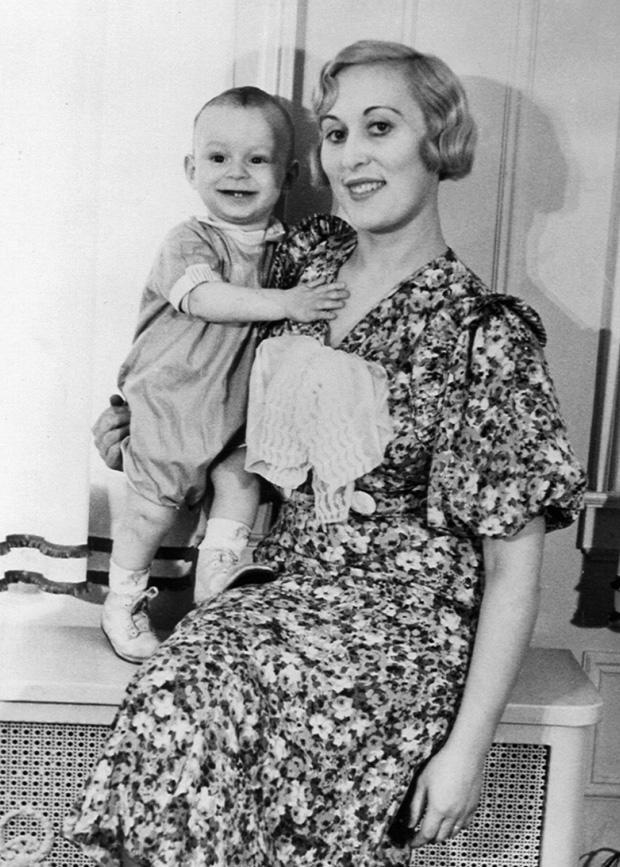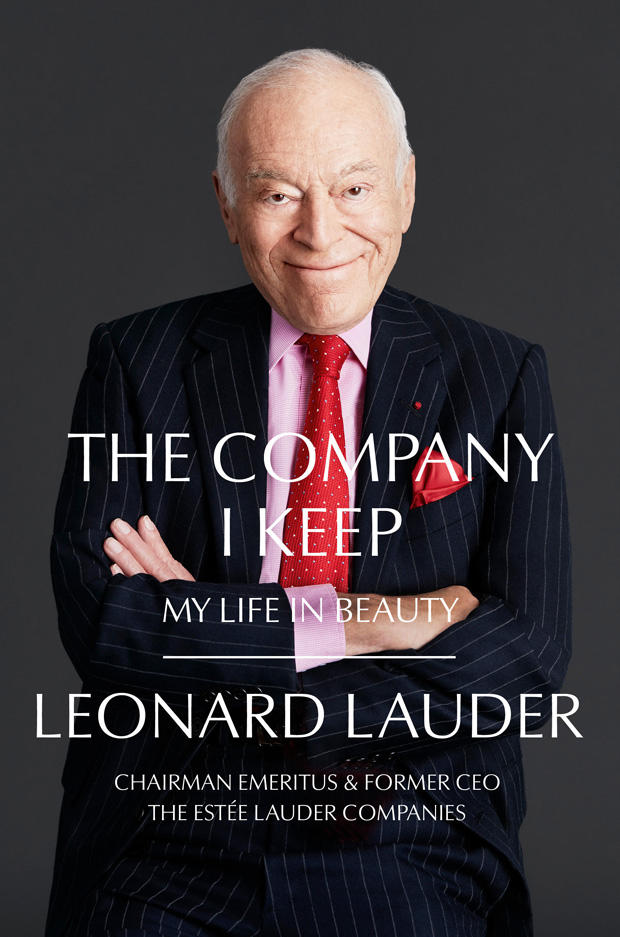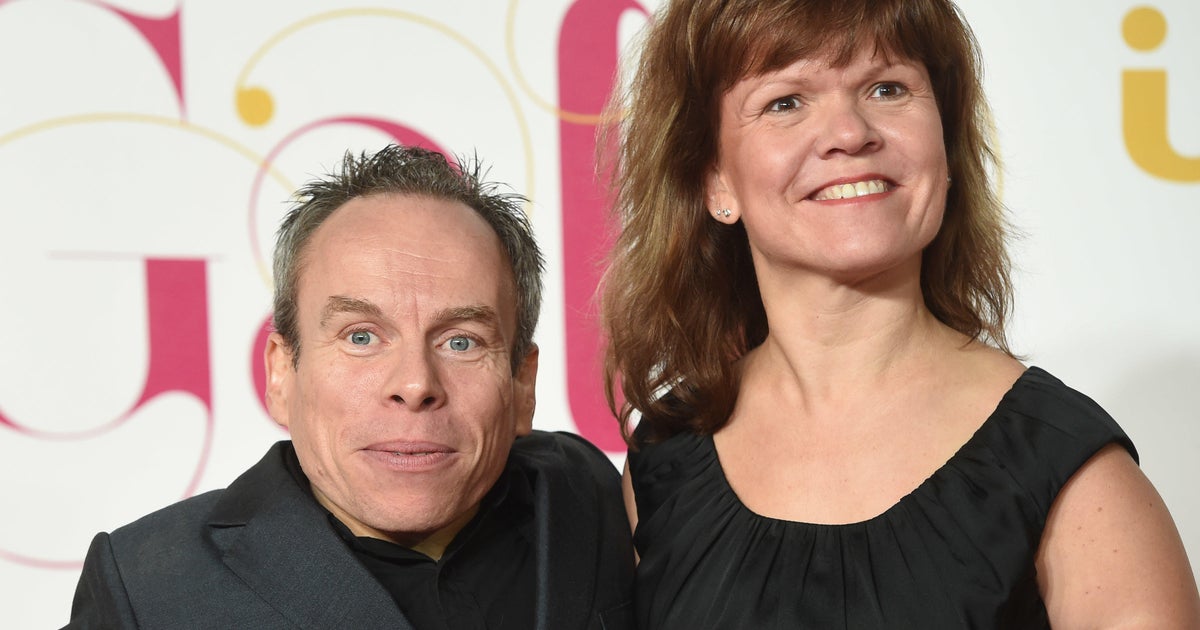Book excerpt: The origin story of Estée Lauder, from "The Company I Keep"
In "The Company I Keep: My Life in Beauty" (Harper Business), Leonard Lauder, chairman emeritus and former CEO of the Estée Lauder Companies, has written a book that is equal parts biography, business tome, philanthropy, and tribute to his mother, Estée Lauder, a woman who founded a cosmetics empire with beauty creams cooked up in the kitchen.
Read the excerpt below, and don't miss Alina Cho's interview with Leonard Lauder on "CBS Sunday Morning" November 15!
"Fiddling With Other People's Faces"
My mother wasn't like other mothers.
When I was growing up in the 1930s, I remember sitting in the kitchen, watching my mother cook up facial creams on the stove. We lived in a series of residential hotels on New York's Upper West Side. These were ordinary apartment buildings with one difference: the building provided maid service. My mother liked the convenience of not having to make the beds.
Even then, her focus was on her business.
I'd come home from elementary school to a home-cooked hot lunch. (Lamb chops with mint jelly and mashed potatoes is still my favorite meal.) Then the doorbell would ring with a customer: women who wanted to learn how to use the velvety, sweet-smelling potions that made their face feel as smooth and supple as fine silk. While I kept busy in the living room, my mother gave them facials in the bedroom. I often heard her encouraging them to care for their skin with what became her signature phrase: "Every woman can be beautiful." And it was true: when the women walked through the living room after their treatments, their skin glowed. And their purses often held a few newly purchased black-and-white containers labeled "Estée Lauder."
I was born in 1933, the same year that my mother founded what would become The Estée Lauder Companies. Today, the company that bears her name comprises over 25 brands sold in some 150 countries and territories. Back then, though, success was measured in individual jars. The company and I grew up together, our lives as closely paired as twins. It has always been more than a family company: it was – and continues to be – my family.
This is our story. It's the story of a family's transformation, of a company's creation, of a changing world, and of my own personal journey as I learned to navigate through life, love, and Estée Lauder.
"I Liked To Make Them Pretty"
Creating beauty was something my mother had been doing ever since she was a young child.
The woman who would become Estée Lauder was born on July 1, 1908, as Josephine Esther Mentzer, the daughter of Rose Schotz Rosenthal and her second husband, Max Mentzer. Rose had emigrated from Hungary and Max from Slovakia; both ended up in Corona, Queens, where Max ran a hardware store and they lived above the shop.
That part of Queens then was a loud and lively place, crowded with a rapidly growing population of Italian, Eastern European, German, and Irish immigrants and noisy with ongoing construction. It was in a constant state of flux, with new industries and roads springing up in the wake of the 1909 completion of the Queensboro Bridge. The Brooklyn Ash Company and other businesses used the marshland adjoining Flushing Bay to dispose of cinders and garbage from nearby boroughs. Heaps of refuse piled up more than sixty feet high and were referred to as "Corona Mountain."1 The area was later immortalized by F. Scott Fitzgerald in The Great Gatsby as "the Valley of Ashes."
But it was also pulsing with vitality and purpose. All of those immigrants had come to the United States to make a better life for themselves and their children, and they were pouring their energies into that goal. Their children, born in America, tended to shun their straitlaced European backgrounds and threw themselves into assimilating. My mother later wrote in her autobiography, Estée: A Success Story, "I wanted desperately to be 100 percent American." That meant learning to speak unaccented English and to spot and seize the opportunities that would enable her to leave Queens and explore a wider world.
Like many little girls, Esty, as her family called her, liked to play with her mother's skin creams and comb her girlfriends' hair. But her interest in beauty makeovers went far beyond most little girls' experiments. Family, friends, and later classmates – anyone who sat down long enough – was subject to one of her "treatments," to the point that Max expostulated, "Esty, stop fiddling with other people's faces." But, as she wrote, "this is what I liked to do – touch other people's faces, no matter who they were, touch them and make them pretty."
After school and on weekends, Esty helped out at her father's hardware store. Her special job was creating the window displays that would attract customers. For the Christmas holiday season, she would decorate a hammer or a set of nails with extravagant bows and gift wrap, then place it under an artificial tree. Customers responded, and she learned an important lesson. "Packaging required special thought," she would write. "You could make a thing wonderful by its outward appearance. There may be a big difference between lipstick and dry goods, between fragrance and doorknobs, but just about everything has to be sold aggressively."
She also helped at another family business, a neighborhood department store run by Fanny Rosenthal (the wife of Esty's older half brother, Isidor Rosenthal) and Fanny's sister, Frieda Plafker. Plafker & Rosenthal was, my mother remembered, "my gateway to fancy. It was Dress-Up Land for me. I loved to play with the beautiful clothes, touch the smooth leather gloves, pull the lace scarves around my shoulders." (As a little boy, I used to play hide-and-seek with my cousins in the shoe storeroom in the back.)
It was also an education in salesmanship. Like most department stores at the time, Plafker & Rosenthal was predominantly a woman's world. Women came as much for the fun of ogling the goods and the thrill of buying them as to meet with their friends in a comfortable setting that was a combination of emporium, playground, and sorority clubhouse. At Plafker & Rosenthal, female customers were waited on by saleswomen who literally spoke their language; Fanny and Frieda could chat in Yiddish with Jewish shoppers and rattle off idiomatic Neapolitan to their Italian clientele. They kept the store open six and a half days a week and stocked it with everything from menorahs to Communion dresses.
My mother learned how to talk to everyone and relished it. With her bubbly personality and genuine interest in women's lives – and their complexions – she fit right in.
As my mother happily immersed herself in an atmosphere created by women for women, she observed what women liked, how they liked it, and how to sell it to them. "I whetted my appetite for the merry ring of a cash register," my mother would write. "The ladies came to buy, and smiled and bought more when I waited on them. I knew it. I felt it. I learned early that being a perfectionist and providing quality was the only way to do business."
My mother learned a valuable lesson at an early age: even though women still couldn't vote, they could run a successful business, make money, and use it to surround themselves with beautiful things.
The Science Behind The Magic
Retailing wasn't the only business welcoming to ambitious women. In the years after World War I, two female entrepreneurs were making their mark in the cosmetics industry: Helena Rubinstein and Florence Nightingale Graham, better known as Elizabeth Arden.
Madame, as Helena Rubinstein liked to be called, and Miss Arden, as she liked to be called, couldn't have come from more different backgrounds: the former was one of eight daughters growing up in a cramped Orthodox Jewish household in the Polish city of Krakow; the latter was raised on a small farm in Ontario, Canada, where she bathed once a week on Saturday night before Sunday church and washed her hair once a month. Yet by the time my mother was a teenager, both were on their way to building global business empires, their names etched above chains of beauty salons and on products from powder to perfume to waterproof mascara. At the height of their fame, Madame and Miss Arden were recognized as the richest, most powerful self-made women in the world.
As someone who loved to help women look and feel beautiful, my mother would have had to be blind and deaf and living in a cave not to be aware of how their products were advertised to and used by more and more women. My mother was neither blind nor deaf, and Corona was no cave.
From behind the counter at Plafker & Rosenthal and on the streetcars trundling into Manhattan (the #7 subway line to that part of Queens wouldn't be completed until 1928), my mother saw women spending money on powder, rouge, and lipstick in ways her own mother could never have imagined or condoned. Having successfully stepped into what were traditionally men's jobs during World War I, women were enthusiastically exploring new roles in the post-war professional world. (The number of working women would increase by 25 percent in the 1920s.) They had newfound confidence and, thanks to their earnings, the money to express that confidence through cosmetics.
At the same time, motion pictures, fashion magazines, and the society columns of newspapers popularized a new look: the plucked brows, pouting crimson lips, shaded and outlined eyes, and feathered lashes of the Jazz Age flapper. Once considered vulgar, makeup was now meant to be noticed. Applying it was no longer a secret confined to boudoirs and powder rooms; touching up your lipstick in public was considered a statement of independence and modernity, and manufacturers soon supplied portable powder compacts and artistically decorated lipstick tubes. Judge magazine, a popular satirical weekly, heralded football season with an illustration of a stylish young coed, cloche hat on head and Yale pennant on display, nonchalantly checking her lipstick in her mirrored compact.
The voracious demand for cosmetics rippled through the entire economy. In 1923, The Nation magazine estimated that the "factory value of cosmetics and perfumes in [the] U.S. was seventy-five million [dollars] – an increase of 400 percent in ten years." By 1929, Fortune magazine would announce that the giant mail-order company Sears, Roebuck & Company sold more face powder that year than it sold soap, toothpaste, and shampoo – combined.
The new products and their ostentatious use made the traditional mother-to-daughter transfer of discreet beauty tips obsolete, so young women turned to a new source of wisdom: the beauty columnist. By the mid-1920s, most magazines and newspapers had regular columns offering advice on new products and their application. Even local radio stations gave lessons in beauty culture. The beauty industry was here to stay.
I'm sure my mother soaked it all in.
When she was sixteen, Esty found someone who loved "fiddling with other people's faces" as much as she did. Her mother's brother, John Schotz, a chemist, had left Hungary before World War I and settled in New York. Now, in 1924, he started a small business called New Way Laboratories, making beauty products, suppositories, freckle remover, a treatment for dog mange, and something called Hungarian Mustache Wax. He was also an "esthetician," the term for someone who did facials.
(A crucial definition: a facial is a treatment that uses creams; a makeover is one that uses makeup. If you think of a woman's face as artwork, a facial prepares the canvas; a makeover paints it.)
My mother couldn't have cared less about suppositories and dog mange cures. What captured her attention was what she called her Uncle John's secret formula, something she described as "a precious velvety cream ... that magically made you sweetly scented, made your face feel like spun silk, made any passing imperfection be gone by evening."
The cream may have had magic powers but Uncle John cooked it up in the most mundane setting: initially, on the gas stove in the family kitchen and later in a modest laboratory above the Longacre Theatre on Broadway. Moreover, this quiet, bespectacled man understood his niece's interest and encouraged it. And he was willing to teach her his secrets: why a particular compound cleared up blemishes; which ingredients made an especially effective moisturizer; that cleansing oil was gentler on sensitive facial skin than soap. "I was smitten," she recalled. "After school, I'd run home to practice being a scientist."
Like a good scientist, she experimented constantly, noting how her uncle prepared each product, trying out different formulas on her friends, and keeping a careful record of the results. My mother liked to say that she didn't have a single friend whom she didn't slather in the creams. "If someone had a slight redness just under her nose that was sure to emerge into a sensitive blemish the next day, she'd come to visit. I'd treat her to a Creme Pack – voila! – vastly improved skin the next day. Friends of friends of friends appeared. My reputation among my peers at Newtown High School grew by leaps and bounds."
Uncle John was an expert at hands-on demonstrations, and under his tutelage, Esty learned that a quick massage with the cream helped refresh a woman's face. She became so skilled that she could give a complete facial and makeover – cleansing oil, cream, rouge, powder, lip color, and often eye shadow – in less than five minutes.
And she always thanked her subjects with a generous sample of the magic cream.
Giving away the Super Rich All-Purpose Creme, as my mother named it, ensured that she was a very popular girl during her senior year of high school. But, she would write, "Deep inside, I knew I had found something that mattered much more than popularity. My future was being written in a jar of cream. My moment had come and I was not about to miss seizing it."
From the book "The Company I Keep" by Leonard Lauder. Copyright © 2020 by Leonard Lauder. Reprinted courtesy of Harper Business, an imprint of HarperCollins Publishers.
For more info:
- "The Company I Keep: My Life in Beauty" by Leonard Lauder (Harper Business), in Hardcover, eBook and Audio formats, available via Amazon and Indiebound
- Estée Lauder Companies
- The Lauder Family (elcompanies.com)





